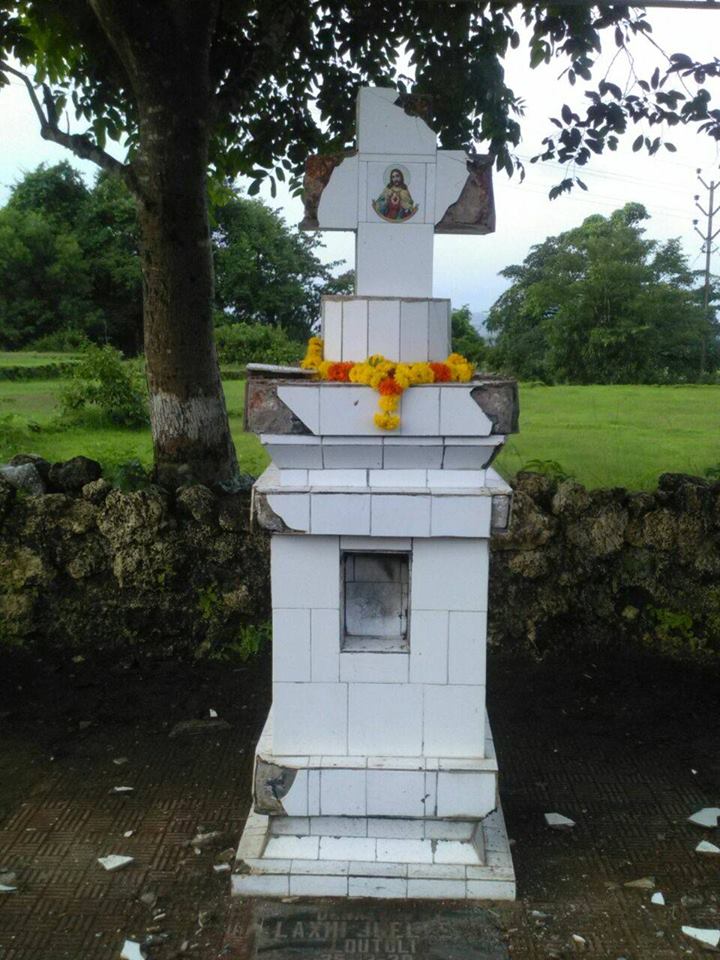 Image courtesy: Facebook page, oHeraldoGoa.
Image courtesy: Facebook page, oHeraldoGoa.
Since early July, Goans have woken to the shock of daily headlines reporting desecrations, mainly of Catholic religious sites, apart from two idols inside a Krishna temple including that of a nandi. Many wayside crosses in villages have been knocked down. The latest was a vicious attack on the cemetery of the Guardian Angel Church in Curchorem — where 28 niches, five wooden crosses, nine granite crosses, 16 tombs and a big cross on the arch opening into the cemetery were vandalised. All this was clearly the work of a group using heavy instruments.
Every one of these sites is situated in South Goa. South Goa is credited with winning many battles to preserve Goa’s identity: the Opinion Poll which saved Goa from being merged with Maharashtra; the declaration of Konkani as the official language (though there is still a struggle over scripts); and voting in each election to preserve the secular fabric of the state. The BJP has won seats here by supporting Catholic candidates, a precarious balance for the government at the moment, as it is a coalition government which has had to hold in abeyance measures such as the beef ban, for instance. This spate of malevolence is perhaps an attempt to discredit the government and create discord.
The RSS-backed Bharatiya Bhasha Suraksha Manch (BBSM) has been demanding that regional languages (Konkani and Marathi) be made the medium of instruction in Goa’s elementary schools, and that the government should stop the grants of English medium schools. The party lost all seats contested in the elections, and currently has no MLA that supports its cause. Their main target is the Diocesan Society of Education, whose primary schools are English medium; its tirades are aimed almost solely against the Catholic community. Their current strategy is to embarrass the BJP government in power.
The Sanathan Sanstha, a Goa-based rightwing Hindu outfit some of whose sadhaks (seekers) are under the scanner of investigating agencies looking into the killing of some rationalists, has had a presence here for some years, held meetings, and made controversial statements. Pramod Muthalik, chief of the Mangalore-based Sri Ram Sene, responsible for moral policing and attack on a pub in Mangalore, has tried, at various times to muddy our waters. But his entry has been banned for several months at a time, starting with the Congress government and continued by the BJP. Sadhvi Saraswati addressed the Sixth All India Hindu Convention held at the Ramnathi temple in Ponda: “People who take it as status symbol to eat beef… I request the Centre to hang them in public.” The lawyer Albertina Almeida writes: “There have been various Hindu Rashtra meetings brazenly hosted on Goan territory, with no reprimand by the State through its criminal justice system for the threatening statements made during and post these meetings.”
Our state is often praised for its communal harmony, and the BJP flaunts this quality when it is in power. Despite transformations effected by social engineering in the early years of Portuguese colonialism, which changed social relations, there has been peace. It has been argued that life was stable and without strife, because the two communities lived separate lives. Yet in our community life, political, religious and cultural dimensions merge and flow, as do our streams and rivers, into the great sea of Goan experience. It is an environment, and a way of life, that has charmed the well-to-do in Delhi, Mumbai and elsewhere into crowding our spaces with second homes.
But Goa has been no different when it comes to exploitation of all communities by the brahmins in the past. Goan society leaves more room for individual freedom than anywhere else in India. There could be several reasons for this, reasons that are to do with temporal rather than religious considerations. However, the influence of Buddhism, Jainism, Islam, the Bhakti movement and Christianity, must have led to a process of leavening and softening of the hierarchical rigidity seen elsewhere in India. Poet Bakibab (B.B.) Borkar described this component of the Goan personality as veglenchmunxaponn, a unique humanism.
Although there is a growing disquiet over the cultural transformations in other parts of the country, the Goan, who has gone about his business peacefully so far, has not felt threatened. Agitations have focused on the government’s support of excessive mining, casinos, environmental degradation. The desecrations this month, and the inadequacy of police action, have aroused anger and anxiety. Wayside crosses abound in our villages – honoured and venerated by everyone. Flowers and garlands adorn them, candles are lit around them. Cars and trucks slow down. The driver alights, bows and prays, then proceeds on his way. The Vashem cross broken in Loutulim – my ancestral village – was, in fact, renovated by the Shetyes, a Hindu community of jewellers. Religion in Goa is not divisive. There are many examples of cultural assimilation, not least the prominent transformation of the goddess Santeri.
Barring only two shrines outside Goa to goddess Santeri (and these are in the neighbouring state of Karnataka), it is only in Goa that Santeri is worshipped in various transformations, including as her sister Saibin Mai, the Virgin Mary of the Christians. Her special attributes are peace, fertility and protection — which Goa is proud to give as its special contribution to the Indian tradition. And this will ensure the defeat of political forces trying to sow discord. The singer Hema Sardesai is to lead a peace rally and concert Sunday July 16th.
Eminent writer and teacher Maria Couto’s books include Goa: A Daughter’s Story and Filomena’s Journeys: Portrait of a Marriage, a Family and a Culture.




